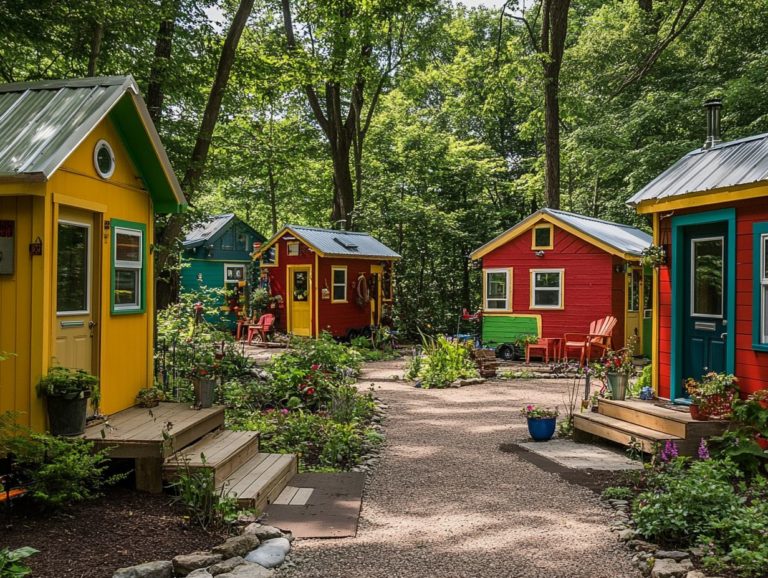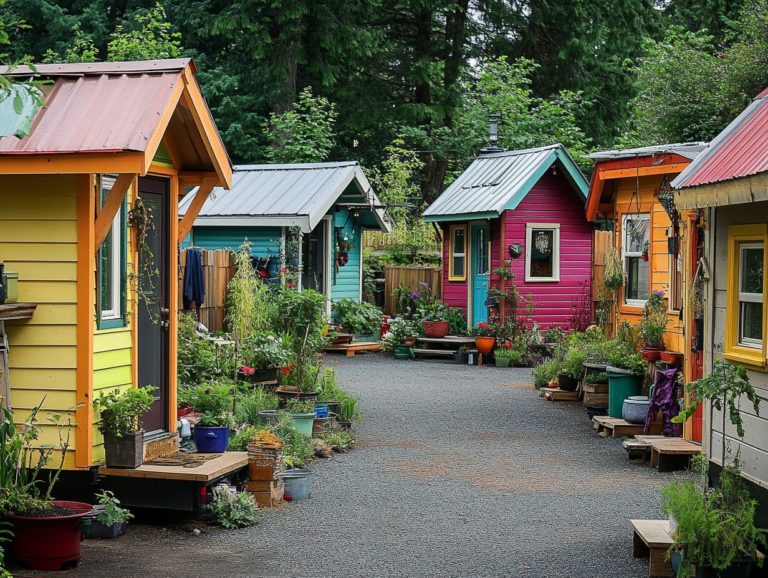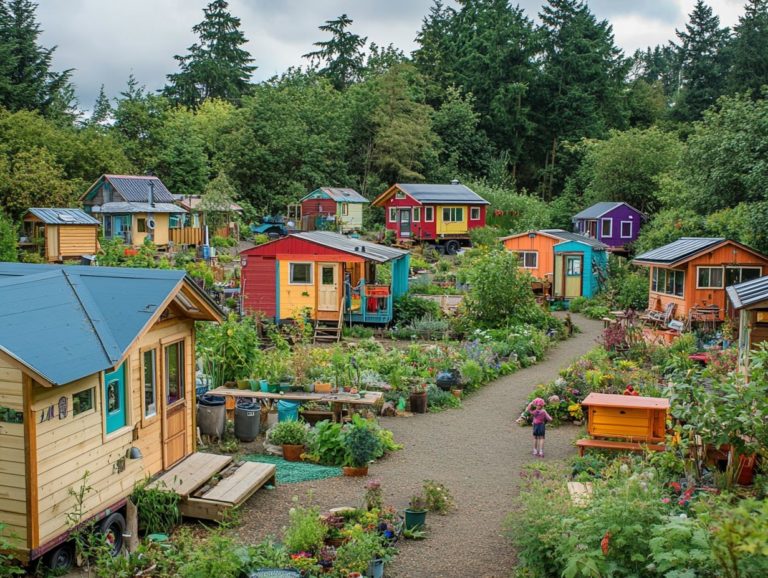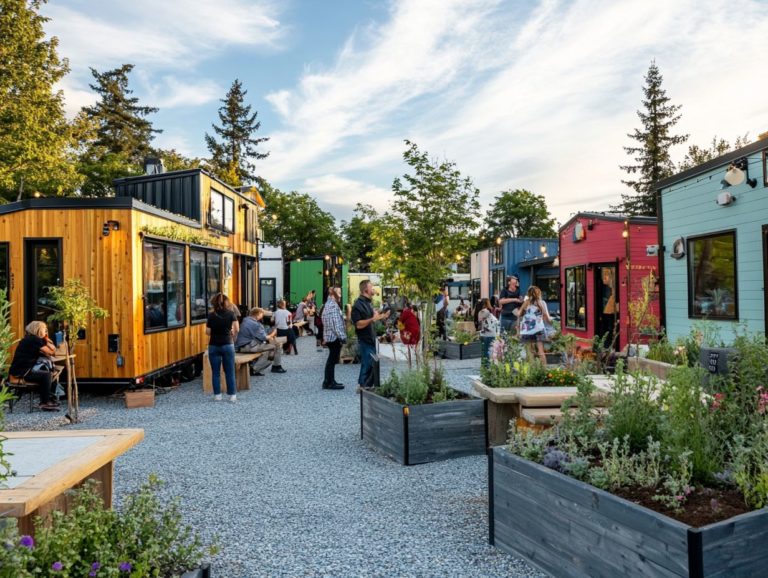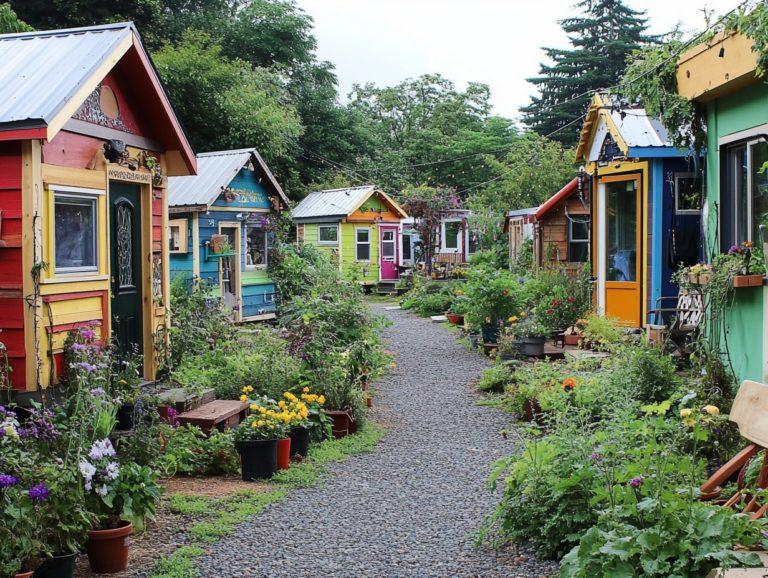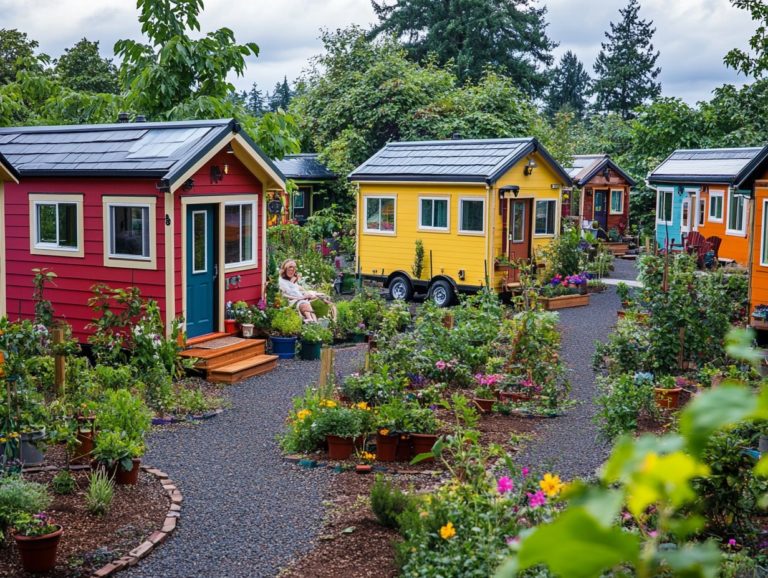Emerging Trends in Tiny House Communities
Tiny house communities are revolutionizing your perspective on living spaces, providing distinctive advantages that extend far beyond simply downsizing.
With financial savings and environmental benefits at the forefront, these communities redefine lifestyle choices for the modern individual.
In this article, you’ll explore the diverse types of tiny house communities, uncover emerging trends that prioritize sustainable living and shared amenities, and address the challenges they encounter, including zoning issues and societal perceptions.
Discover how tiny house living might just be the exciting solution you’ve been searching for!
Contents [hide]
- Key Takeaways:
- Benefits of Living in a Tiny House Community
- Types of Tiny House Communities
- Emerging Trends in Tiny House Communities
- Challenges and Solutions for Tiny House Communities
- Frequently Asked Questions
- What are some emerging trends in tiny house communities?
- Are tiny house communities becoming more popular?
- How do tiny house communities promote a sense of community?
- What are the benefits of living in a tiny house community?
- What challenges do tiny house communities face?
- How is technology impacting the development of tiny house communities?
Key Takeaways:
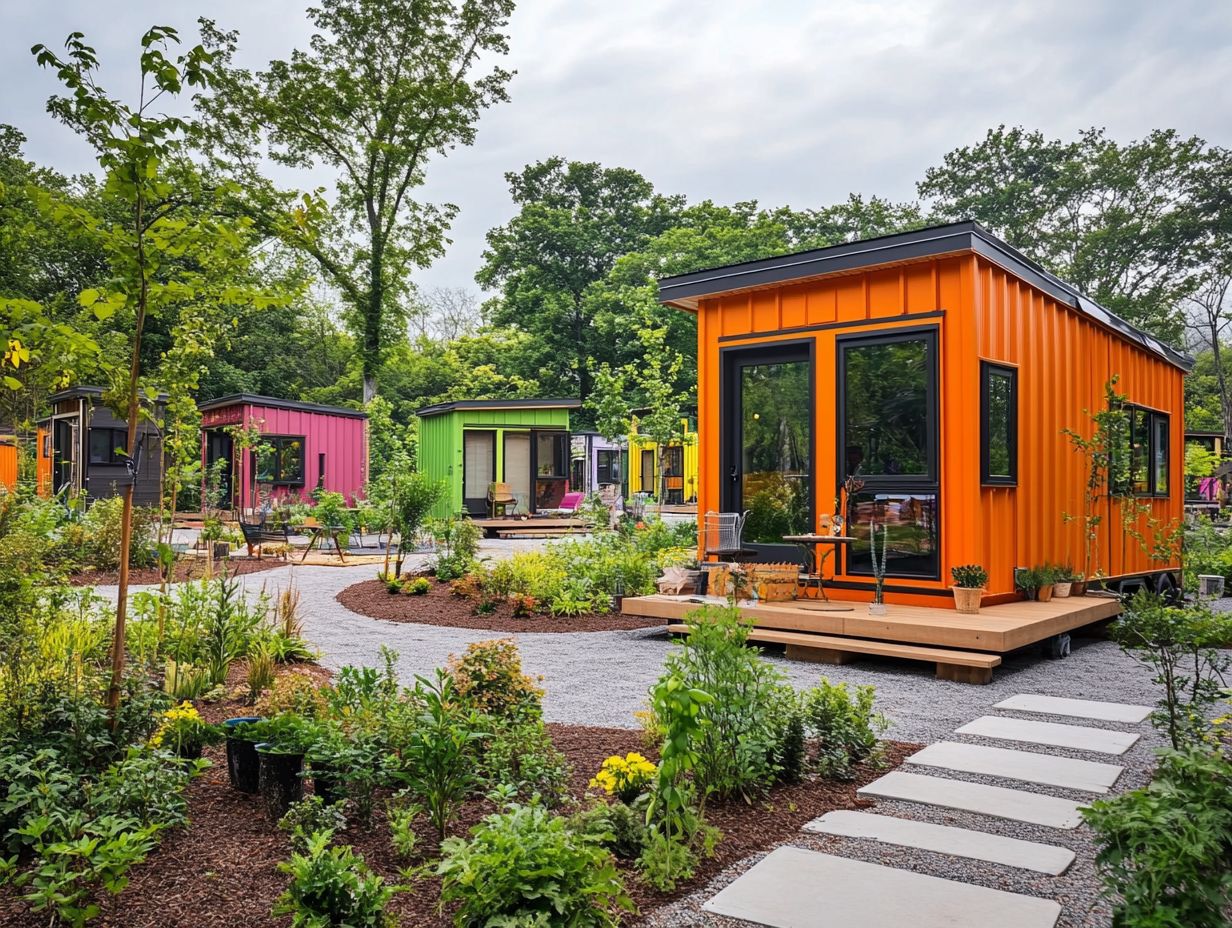
- Tiny house communities offer financial and environmental benefits, making them a viable housing option that aligns with the Tiny House Movement.
- Emerging trends include sustainable designs, shared spaces, and the integration of technology.
- Zoning, community management, and addressing stigmas are key challenges for the growth and success of tiny house communities.
Defining Tiny House Communities
Tiny house communities represent a transformative approach to modern living, blending the principles of tiny homes with the essence of community. Spanning the USA from California to Oregon, Texas, and North Carolina, including vibrant cities like Portland and Seattle, these communities foster connections among residents while embracing a simpler lifestyle aligned with the Tiny House Movement.
They prioritize affordable housing options and emphasize sustainable living, minimizing environmental impact making them a green choice in a world increasingly focused on social and environmental consciousness.
Living in a tiny house community allows you to lighten your financial load with lower housing costs while also engaging in meaningful social interactions. For instance, in a tiny home community in Texas, including areas like Austin, shared resources like community gardens and workshop spaces encourage collaboration and mutual support among residents. If you’re interested in exploring this lifestyle further, check out tiny house communities: a guide for beginners.
Similarly, Oregon showcases communities that harness renewable energy sources, featuring eco-friendly homes like modular homes and mini houses, demonstrating a strong commitment to sustainability. This collective approach nurtures a sense of belonging, enabling you to lead a purposeful life while supporting a greener lifestyle.
Benefits of Living in a Tiny House Community
Residing in a tiny house community presents a wealth of advantages tailored for those who aspire to achieve financial freedom and embrace a simpler way of life, all while minimizing your environmental footprint.
These distinctive living arrangements render affordable housing attainable while fostering a vibrant sense of community. For those considering this lifestyle, understanding life in a tiny house community is essential, as shared resources and mutual support thrive, filling a void often felt in conventional neighborhoods.
Financial and Environmental Advantages
The financial and environmental benefits of tiny house communities are remarkable, offering you a pathway to financial freedom while simultaneously lowering your carbon footprint. By embracing affordable housing options and exploring home improvement projects, you can save significantly on mortgage payments, utility costs, and maintenance.
This change helps create a strong sense of community among residents. Tiny house communities typically emphasize sustainable designs that incorporate renewable materials, energy-efficient appliances, and innovative water conservation systems, reflecting modern tiny home design. For those interested in exploring unique tiny house communities around the world, these choices not only reduce energy consumption but also positively impact the surrounding environment, helping to combat climate change.
As you experience less financial strain, you re given the power to engage more fully with your community, support local businesses, and take part in social initiatives. This engagement enhances your quality of life and creates a ripple effect of positive change for everyone involved.
Types of Tiny House Communities
Tiny house communities come in various forms, including eco-friendly homes and modular homes. Each has its own charm and appeal, depending on its location and design. You might find them in tranquil rural settings, vibrant urban centers, or even as mixed-use developments. Each offers unique advantages and living experiences.
Whether you prefer the peacefulness of the countryside or the energy of an urban landscape, these tiny house communities are reshaping the concept of affordable housing. They present exceptional opportunities for meaningful community living while showcasing innovative design and maximizing space efficiency.
Rural, Urban, and Mixed-Use Communities
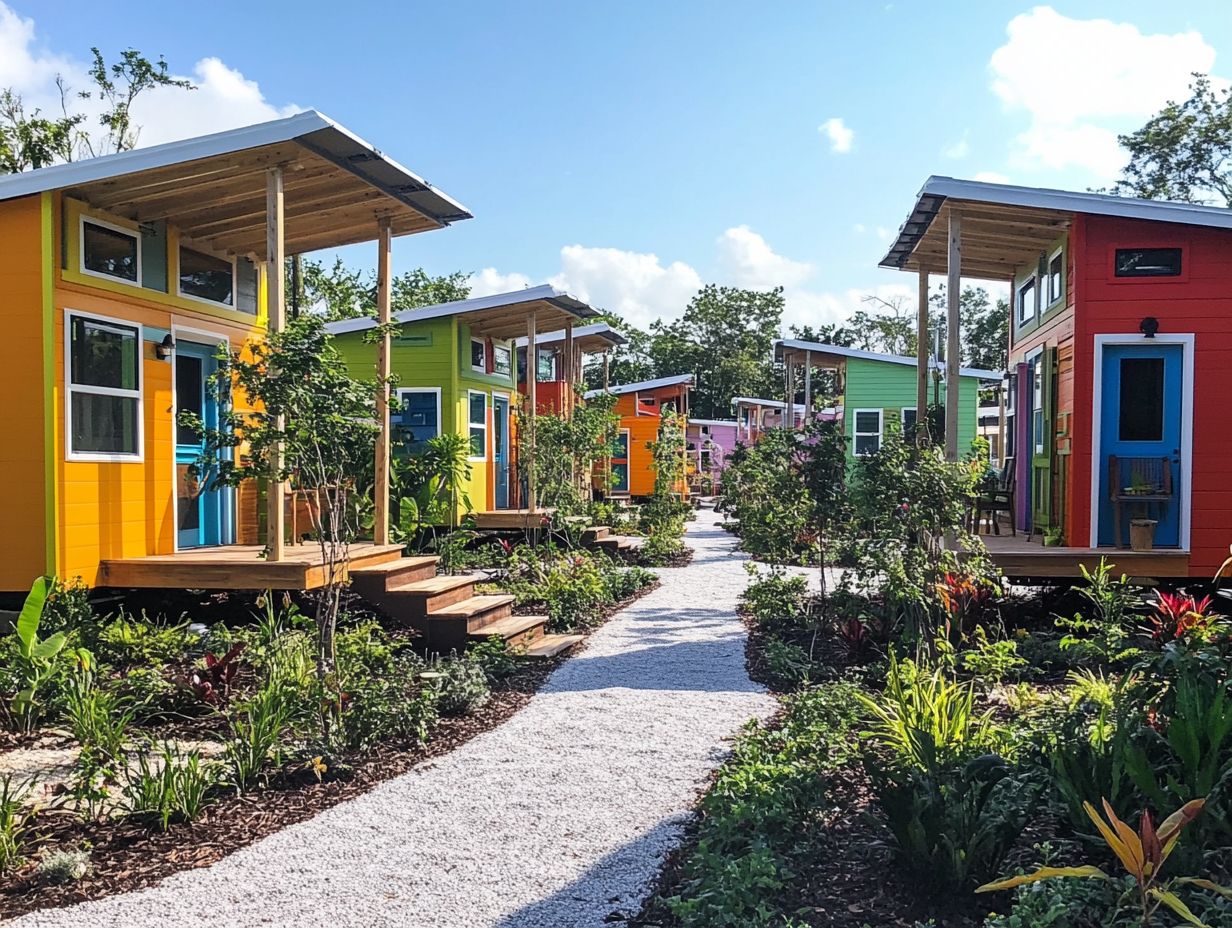
Rural, urban, and mixed-use communities showcase the rich tapestry of environments where tiny houses can truly flourish. Each presents its unique advantages and challenges in community living. In rural settings, you ll find tranquility and a direct path to nature.
Urban landscapes prioritize convenience and the close availability of amenities. Mixed-use developments artfully combine both worlds, fostering a holistic lifestyle experience that caters to diverse needs.
In rural areas, smaller homes nestled within vast expanses of land appeal to those yearning for peace and a closer bond with nature. This makes them particularly attractive for families or retirees in search of a serene retreat.
Conversely, urban environments emphasize space efficiency, creating a vibrant social scene that draws in young professionals and students eager for accessibility and various lifestyle options.
Mixed-use communities emerge as a compelling solution, seamlessly blending residential and commercial spaces. This integration allows individuals from various backgrounds to share resources and promote sustainable living, ultimately crafting affordable housing solutions that cater to the evolving needs of today’s diverse demographics. For those considering this lifestyle, understanding how to choose the right tiny house community is essential.
Emerging Trends in Tiny House Communities
Emerging trends in tiny house communities reveal a growing commitment to sustainable living. This includes the rise of eco-friendly homes and innovative design, fundamentally reshaping the future of community life.
These communities are evolving to include eco-friendly homes, such as pre-manufactured homes built off-site, and shared amenities that foster social interactions while prioritizing environmental responsibility, highlighting the benefits of living in a tiny house community.
Sustainable and Eco-Friendly Designs
Sustainable and eco-friendly designs are leading the charge in tiny house communities, establishing a new benchmark for environmentally conscious living. With features like solar panels and composting toilets, these homes not only shrink their carbon footprint but also cultivate a lifestyle intricately linked to nature and conservation.
Tiny houses often utilize reclaimed materials, maximizing resource efficiency while minimizing waste. Insulation made from recycled products enhances energy efficiency, allowing you to enjoy a comfortable atmosphere year-round without becoming overly dependent on conventional heating or cooling systems.
Rainwater harvesting systems exemplify this commitment to sustainability, supplying fresh water for gardening and household use. These elements play a vital role in preserving our planet and inspire residents to actively participate in eco-friendly practices.
Ultimately, this transforms the living experience into one that is both sustainable and deeply enriching, paving the way for future trends in homeownership.
Explore tiny house communities today and discover the future of tiny house design as you join the movement towards sustainable living!
Inclusion of Shared Spaces and Amenities
The inclusion of shared spaces and amenities in tiny house communities cultivates a sense of belonging and encourages meaningful social interactions among residents. These common areas think gardens, kitchens, and recreational facilities not only elevate your living experience but also enhance the environmental footprint by fostering resource-sharing and collaboration.
Take communal gardens, for example. You and your neighbors can grow food together, embracing sustainable practices that help reduce individual resource consumption. An onsite shared kitchen can serve as a lively hub for potluck dinners and cooking classes, allowing you to bond over delicious culinary adventures.
Recreational spaces, whether they boast fire pits, picnic areas, or even small theaters, become ideal settings for hosting events that unite everyone in the community. All of these elements weave together to create a vibrant atmosphere where friendships blossom while promoting eco-friendly lifestyles that benefit everyone involved.
Integration of Technology
The integration of technology in tiny house communities is revolutionizing the way you engage with your living space and your neighbors. From smart home features that make your home more comfortable and efficient to new ways to work from home and make your living space better, technology is at the forefront of sustainable and eco-friendly living.
Imagine energy-efficient appliances that significantly reduce your electricity consumption, paired with smart thermostats that ensure optimal climate control for year-round comfort. High-speed internet and dedicated workspaces are becoming the norm, giving you the power to excel in your professional endeavors without the confines of a traditional office.
Community-based applications encourage collaboration, allowing you to share resources, organize events, and maintain connections with fellow residents. These innovations simplify your daily tasks and foster a genuine sense of belonging, cultivating a vibrant community that enhances the overall quality of life for everyone involved.
Challenges and Solutions for Tiny House Communities

While tiny house communities offer a wealth of benefits, they come with their fair share of challenges. Issues related to zoning, legal regulations, and community management can complicate the experience. To truly harness the advantages of tiny living, it s essential to address these hurdles with innovative solutions, ensuring that residents thrive in their compact spaces and contribute to the sustainability of their communities.
Zoning and Legal Issues
Zoning and legal issues stand as formidable barriers for tiny house communities, complicating the journey toward affordable housing solutions. Local regulations might dictate where tiny houses can be situated, how they can be constructed, and the allowable density of these communities, often resulting in drawn-out legal disputes that hinder or entirely obstruct development.
Some municipalities have taken the progressive step of introducing special zoning categories tailored for tiny homes, creating a nurturing environment where innovative housing solutions can flourish. Advocacy groups frequently play an instrumental role in this transition, deploying legal strategies like petitions and community outreach to enlighten local governments on the myriad benefits of tiny living, including the importance of sustainability in tiny house communities.
Grasping the intricacies of local laws is vital for you, whether you are a prospective resident or developer; it gives you the power to deftly navigate potential challenges and uncover opportunities for more flexible zoning regulations that champion sustainable, affordable living options.
Community Management and Maintenance
Effective community management and maintenance are vital for ensuring the longevity and success of tiny house communities, as they directly impact your satisfaction and social interactions. By establishing clear guidelines and encouraging teamwork, you help ensure that shared spaces remain functional and inviting, ultimately cultivating a sense of belonging and engagement among residents.
In these close-knit living environments, practices like regular community meetings can be incredibly valuable. They offer a platform for sharing suggestions and concerns. For instance, integrating a conflict resolution framework gives neighbors the power to address issues amicably, preventing minor disagreements from spiraling out of control.
Creating committees focused on maintaining common areas, such as gardens or gathering spots, can foster camaraderie. Organizing seasonal events not only beautifies shared spaces but also strengthens interpersonal connections, reminding everyone that they are part of a supportive network.
A proactive approach to community management can significantly enhance your overall living experience!
Addressing Social Stigmas and Stereotypes
Addressing social stigmas and stereotypes surrounding tiny house living is essential for fostering both acceptance and understanding of this lifestyle choice. Many individuals perceive tiny houses as merely a temporary fix or a less-than-ideal living situation. However, by highlighting the advantages of community living, affordable housing, and a minimalist approach, advocates can play a pivotal role in reshaping public perceptions.
One prevalent misconception is that tiny homes lack sufficient space for personal belongings or a comfortable living environment. In truth, many residents discover that downsizing fuels creativity and encourages them to prioritize experiences over material possessions. Additionally, tiny house communities offer a sustainable living option that fosters a sense of community and shared resources.
Personal narratives from individuals who have embraced this transition reveal how tiny house communities nurture a profound sense of belonging and support, significantly enhancing their quality of life. For instance, one couple shared how they reduced their living expenses and forged strong friendships with their neighbors, creating a network that feels like an extended family. Their experiences reflect the charm of exploring the top tiny house communities in the USA.
Focusing on these transformative experiences can truly inspire change! Proponents of tiny house living can effectively challenge common misconceptions and demonstrate the genuine happiness this lifestyle can offer.
Frequently Asked Questions
What are some emerging trends in tiny house communities?
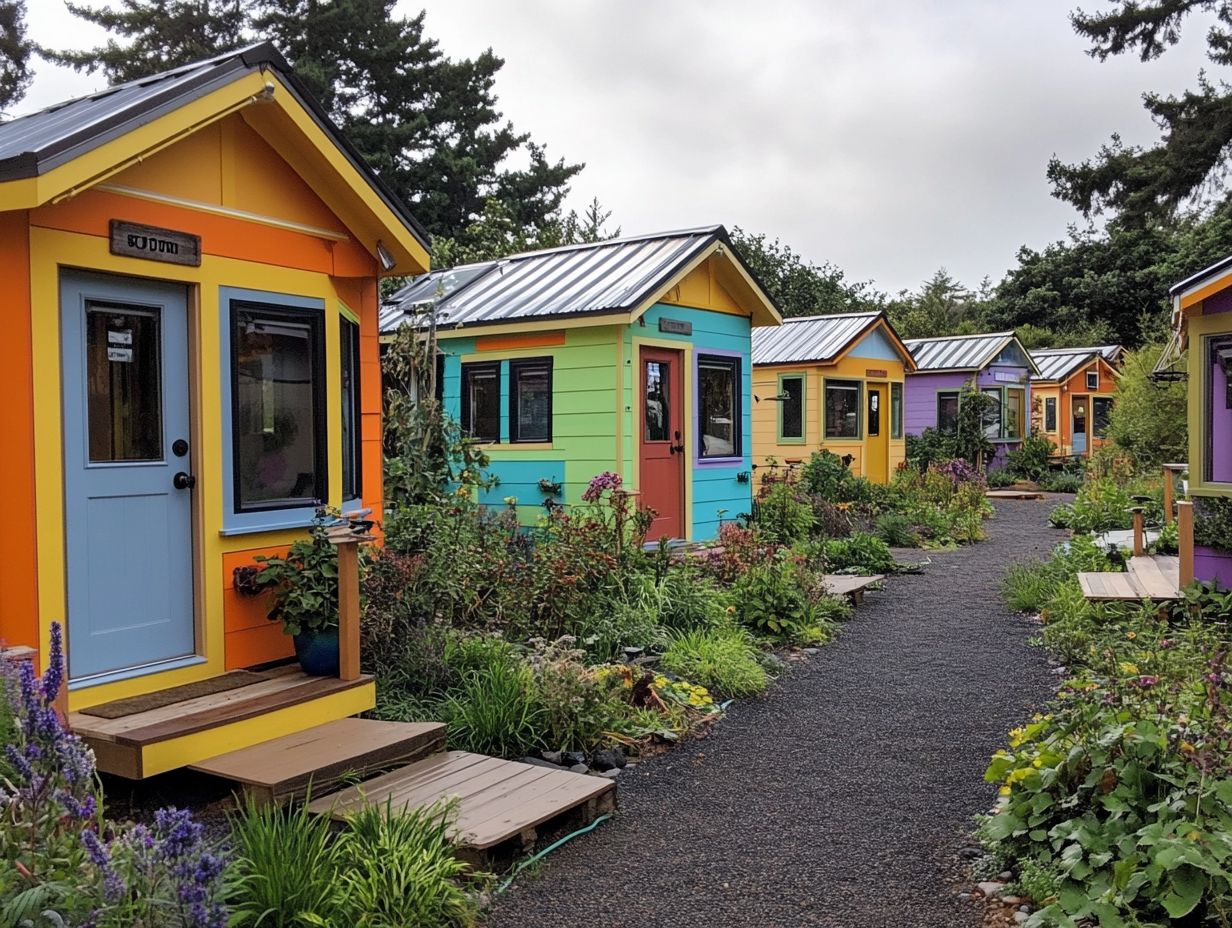
Some emerging trends in tiny house communities include eco-friendly and sustainable designs, shared communal spaces for socializing and community events, and a focus on minimalist and efficient living.
Are tiny house communities becoming more popular?
Yes, they are! More people are seeking affordable and sustainable housing options, and the tiny house movement is gaining momentum.
How do tiny house communities promote a sense of community?
Tiny house communities often have shared amenities and communal spaces, such as gardens, community kitchens, and social gathering areas, which encourage residents to interact and form a sense of community.
What are the benefits of living in a tiny house community?
Some benefits of living in a tiny house community include lower costs of living, reduced environmental impact, and a stronger sense of community and connection with others.
What challenges do tiny house communities face?
Tiny house communities may face challenges such as zoning laws and regulations, limited space and resources, and potential conflicts between community members.
How is technology impacting the development of tiny house communities?
Technology is playing a role in the development of tiny house communities by providing innovative and efficient design solutions, as well as platforms for connecting and organizing with other tiny house enthusiasts and community members.
Consider learning more about tiny house living or engaging with your local community to explore these opportunities!

